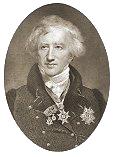Georges-Léopold-Chrétien-Frédéric-Dagobert Baron Cuvier
Zoologist and statesman, b. 23 August 1769 (Montbéliard, France), d. 13 May 1832 (Paris).
 George Cuvier came from a Protestant family which had emigrated from Montbéliard in the Jura mountains of the French-Swiss border to Germany to avoid religious persecution. He studied comparative anatomy at the Karlsschule or Académie Caroline in Stuttgart and learned to dissect.
George Cuvier came from a Protestant family which had emigrated from Montbéliard in the Jura mountains of the French-Swiss border to Germany to avoid religious persecution. He studied comparative anatomy at the Karlsschule or Académie Caroline in Stuttgart and learned to dissect.
Following his graduation he was employed as a tutor from 1788 and began research into marine invertebrates, particularly the molluscs. His research notes came to the knowledge of Étienne Geoffroy Saint-Hilaire, professor at the National Museum of Natural History in Paris, and on Saint-Hilaire's invitation Cuvier returned to France to join the Museum's staff.
Cuvier's life and work were intimately linked with the great changes to which science was exposed at the time. He contributed particularly to advances in three areas: science administration and organization, the classification of animals, and the foundations of geology.
Perhaps his greatest contribution to the advancement of science was Cuvier's service for the public good. Cuvier served as imperial inspector of public instruction, contributed to the establishment of universities in the provinces, and wrote the Rapport historique sur le progrès des sciences naturelles depuis 1789, et sur leur état actuel (1810; "Historical Report on the Progress of the Sciences since 1789 and on their Current State"), which summarized the system of support for the sciences established by the French Revolution. For these services Cuvier was granted the title chevalier in 1811. In 1814 he was elected to the Council of State, and in 1817 he became a vice president of the Ministry of the Interior.
In the area of comparative anatomy Cuvier developed the lectures he held at the Museum into the Tableau élémentaire de l'histoire naturelle des animaux (1797; "Elementary Survey of the Natural History of Animals") and Leçons d'anatomie comparée (1800 - 1805; "Lessons on Comparative Anatomy"). In these works Cuvier struggled with the question of evolution. He argued that the functions and structure of organs are the result of interaction with the environment and that the particular mode of life of animals determines their anatomical form, but he believed that these adaptations were not the result of evolutionary change. On the contrary, he saw the multitude of well-adapted anatomical differences in different animals as an indication of divine creation and insisted that the animal world had to be classified into four distinctly different groups (vertebrates, molluscs, articulates and radiates) from the day of creation. This placed him in opposition to Jean-Baptiste Lamarck and also to Saint-Hilaire, with whom he had originally collaborated.
His comparative study of fossils brought Cuvier to geology. In Recherches sur les ossements fossiles de quadrupèdes (1812; "Researches on the Bones of Fossil Vertebrates") and Discours sur les révolutions de la surface du globe (1825; "Discourse on the Revolutions of the Globe") he explained the discovery of extinct species through a series of catastrophic events of global proportions. He believed that areas covered by massive floods were later repopulated by creatures that survived in regions not reached by the floods. His works gave new credibility to the idea of catastrophism in geology.
Although most of Cuvier's scientific arguments did not stand the test of time, his classification of the animal world Le Règne animal distribué d'après son organisation (1817; "The Animal Kingdom, Distributed According to Its Organization") represented a great advance over the classification of Linneus. He is still held in high regard for his contribution to the advancement of science as an administrator, researcher and teacher.
Reference
Georges Cuvier. Encyclopaedia Britannica 15th ed. (1995)
home
 George Cuvier came from a Protestant family which had emigrated from Montbéliard in the Jura mountains of the French-Swiss border to Germany to avoid religious persecution. He studied comparative anatomy at the Karlsschule or Académie Caroline in Stuttgart and learned to dissect.
George Cuvier came from a Protestant family which had emigrated from Montbéliard in the Jura mountains of the French-Swiss border to Germany to avoid religious persecution. He studied comparative anatomy at the Karlsschule or Académie Caroline in Stuttgart and learned to dissect.